<< Previous | Displaying results 501-550 of 1168 for "holocaust" | Next >>
Exterior view of the ORT (Organization for Rehabilitation through Training) supply and transport building in the Foehrenwald displaced persons camp. Foehrenwald, Germany, 1953. This slide was taken by David Rosenstein during his inspection tour of the camp. After his return from the inspection tour in 1953, he briefed Congress on the plight of the remaining Jewish displaced persons in Europe and their inability to find permanent homes, nine years after the end of the war.
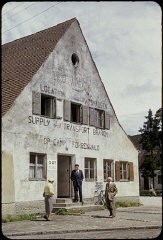
Jewish youth at the "HaRishona" (The First) Zionist training center construct a fishing boat. They are preparing for emigration to Palestine. Fano, Italy, 1946.
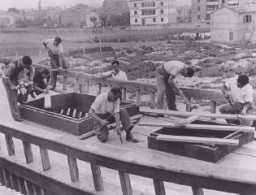
An art class for children in the Fiesole displaced persons camp, outside Florence. Italy, 1946.
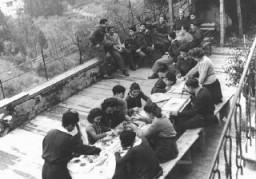
Jewish refugees work on a newspaper at Zeilsheim displaced persons camp. Germany, between 1945 and 1948. The newspaper was titled Unterwegs (The Transient).
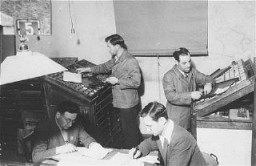
Jewish refugees protest British immigration policy in Palestine. Zeilsheim displaced persons camp, Germany, between 1945 and 1948.
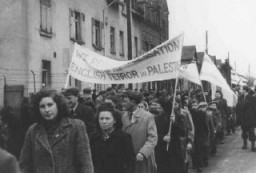
Five Jewish survivors pose for a US Signal Corps photographer in front of Block 2 in the Hanover-Ahlem camp, a subcamp of Neuengamme. Hanover-Ahlem, Germany, April 11, 1945.
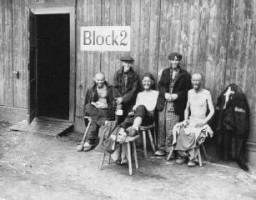
After the liberation of the Wöbbelin camp, US troops forced the townspeople of Ludwigslust to bury the bodies of prisoners killed in the camp. This photograph shows German civilians who were ordered to bury the dead; US troops stand in the background. Germany, May 7, 1945
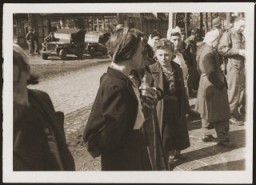
Survivors of the Wöbbelin camp wait for evacuation to an American field hospital where they will receive medical attention. Germany, May 4-6, 1945.
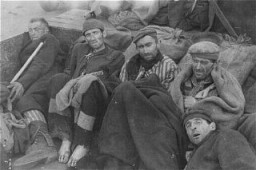
German civilians from Ludwigslust file past the corpses and graves of 200 prisoners from the nearby concentration camp of Wöbbelin. The US Army ordered the townspeople to bury the corpses on the palace grounds of the Archduke of Mecklenburg. Germany, May 7, 1945. Outraged by what they found upon entering the camp, the ranking Allied commanders in the area forced civilians from the nearby towns of Schwerin, Hagenow, and Ludwigslust to view the concentration camp and then bury the bodies of prisoners…
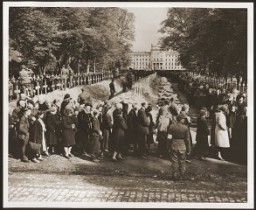
Four emaciated survivors sit outside in the newly liberated Ebensee concentration camp. Photograph taken by Signal Corps photographer J Malan Heslop. Ebensee, Austria, May 8, 1945.
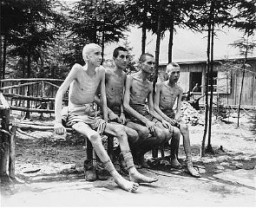
Surrendered Germans in Austria. May 1945. US Army Signal Corps photograph taken by J Malan Heslop.
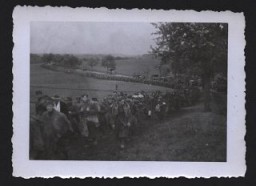
Following World War II, several hundred thousand Jewish survivors remained in camps for displaced persons. The Allies established such camps in Allied-occupied Germany, Austria, and Italy for refugees waiting to leave Europe. Most Jewish DPs preferred to emigrate to Palestine but many also sought entry into the United States. They decided to remain in the DP camps until they could leave Europe. At the end of 1946 the number of Jewish DPs was estimated at 250,000, of whom 185,000 were in Germany, 45,000 in…


Hungarian Jews wait in front of the Swedish legation main office in hopes of obtaining Swedish protective passes. Budapest, Hungary, 1944. Photograph taken by Tom Veres, who was active in Raoul Wallenberg's efforts to rescue the Jews of Budapest.
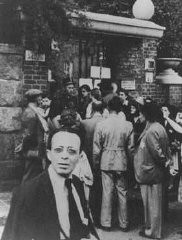
Jews captured by German troops during the Warsaw ghetto uprising in April–May 1943. This photograph appeared in the Stroop Report, an album compiled by SS Major General Juergen Stroop, commander of German forces that suppressed the Warsaw ghetto uprising. The album was introduced as evidence at the International Military Tribunal at Nuremberg. In the decades since the trial this photo has become one of the iconographic images of the Holocaust.
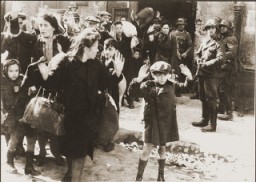
Jews captured during the Warsaw ghetto uprising are marched past the St. Zofia hospital down Nowolipie Street towards the Umschlagplatz for deportation.
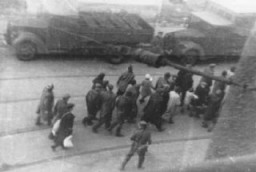
Survivors of the Ebensee subcamp of the Mauthausen concentration camp. Ebensee, Austria, May 8, 1945.
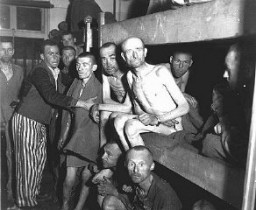
Young German soldiers assist in the deportation of Jews from the Zychlin ghetto to the Chelmno killing center. The Nazis planned this deportation to fall on the Jewish holiday of Purim. Poland, March 3, 1942.
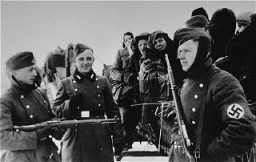
Wedding rings taken from prisoners. The rings were found near the Buchenwald concentration camp following liberation by US Army soldiers. Germany, May 1945.
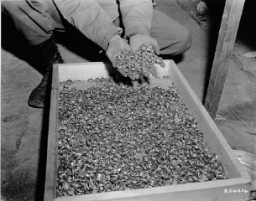
Scene photographed by George Kadish: Jewish prisoners behind a barred window in the Kovno ghetto jail. The Jewish council administered its own jail in the ghetto. Kovno, Lithuania, 1943.
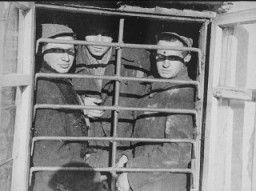
Harry Weinsaft of the American Jewish Joint Distribution Committee gives food to a young Jewish refugee. Vienna, Austria, postwar.
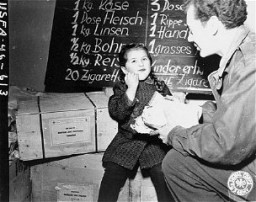
Jewish youth attend a class on transplanting seedlings, part of a general course in farming sponsored by the American Jewish Joint Distribution Committee at the Bergen-Belsen displaced persons camp. Germany, August 1, 1946.
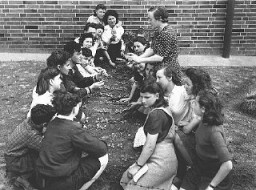
Soviet officers preside over the opening and exhumation of a mass grave at the Ninth Fort. Photographed by George Kadish. Kovno, Lithuania, 1944.
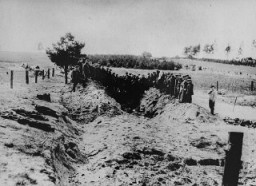
Survivors of Mauthausen cheer American soldiers as they pass through the main gate of the camp. The photograph was taken several days after the liberation of the camp. Mauthausen, Austria, May 9, 1945.
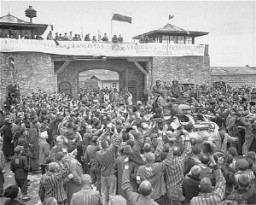
Members of the Bielski partisan group at the site of a mass grave shortly after liberation. Poland, 1945.
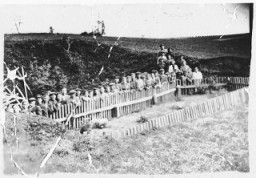
This picture, taken in 2004, shows Blanka Rothschild holding one of her prewar family photographs.
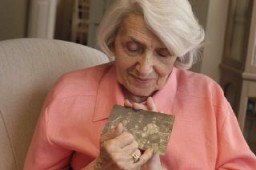
Two German Jewish families at a gathering before the Nazi rise to power. Only two people in this group survived the Holocaust. Germany, 1928.
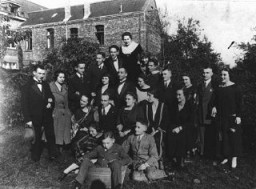
German civilians from Volary attend burial services for the Jewish women exhumed from a mass grave in the town. The victims died at the end of a death march from Helmbrechts, a subcamp of Flossenbürg. Germans were forced to exhume them in order to give the victims proper burial. Volary, Czechoslovakia, May 11, 1945.
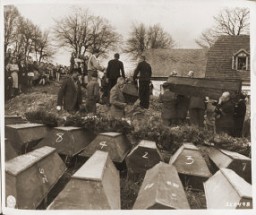
Ruins of a building in the Kovno ghetto gutted when the Germans attempted to force Jews out of hiding during the final destruction of the ghetto. Photographed by George Kadish. Kovno, Lithuania, August 1944.
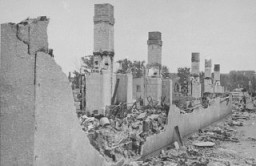
Refugees crowd the rail of the Aliyah Bet ("illegal" immigration) ship Josiah Wedgewood, anchored at the Haifa port. British soldiers transported the passengers to the Athlit internment center. Palestine, June 27, 1946.
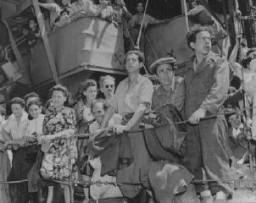
Polish Jewish refugees arriving at Babenhausen displaced persons camp, where the Joint Distribution Committee and the United Nations Relief and Rehabilitation Administration provided aid. Germany, August 20, 1947.
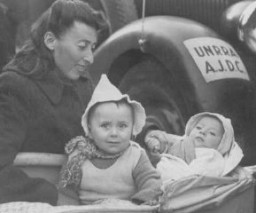
Ukrainian Jews who were forced to undress before they were massacred by Einsatzgruppe detachments. This photo, originally in color, was part of a series taken by a German military photographer. Copies from this collection were later used as evidence in war crimes trials. Lubny, Soviet Union, October 16, 1941.

Regina at the Dueppel displaced persons camp in Berlin-Schlachtensee. Germany, September 10, 1946.
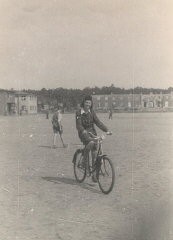
Regina (third from left) with friends while at the Dueppel displaced persons camp. Berlin, Germany, May 20, 1946.
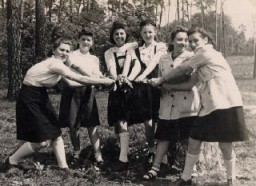
Persecution of Jews and other targeted groups was already government policy in Germany once the Nazis were in power in 1933. But following the German invasion of Poland on September 1, 1939, war provided the opportunity and motivation for more ext...

Diaries reveal some of the most heart-wrenching accounts of the Holocaust. They record the feelings of loss, fear, and sometimes hope of those facing extraordinary peril.
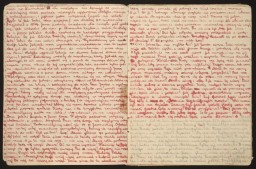
Displaced persons (DPs), Lusia Gliklich (left) and Andzia Dell, stand beside the sign in front of the Düppel Center DP camp, also called Schlachtensee.
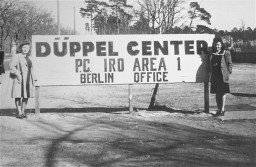
This report card was issued to Regina Laks, a fifth-grade student at the Herzel Hebrew Public School at the Düppel Center displaced persons camp.
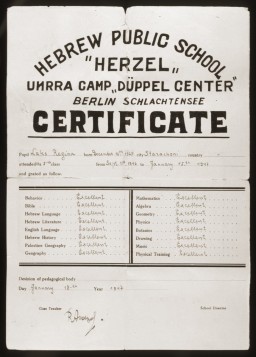
The Kloster Indersdorft displaced persons camp opened in July 1945. By mid-September, 1945, 192 boys and girls from thirteen nations, including 49 Jewish children, were sheltered at Kloster Indersdorf, more than double what had been anticipated. Over the next year, the numbers increased to over 300. Five hours each day were allocated to education. Teachers were drawn from the staff as well as the local community. Many of the children had few or no literacy skills; they also benefitted from art, music,…
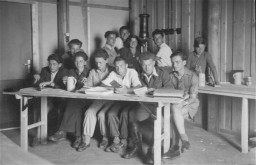
December 17, 1942. On this date, the Allied nations officially declared that German authorities were engaging in the mass murder of European Jews.
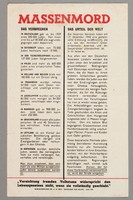
Refugees faced enormous obstacles in finding safe havens during the Great Depression and World War II.
We would like to thank Crown Family Philanthropies, Abe and Ida Cooper Foundation, the Claims Conference, EVZ, and BMF for supporting the ongoing work to create content and resources for the Holocaust Encyclopedia. View the list of donor acknowledgement.